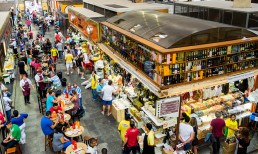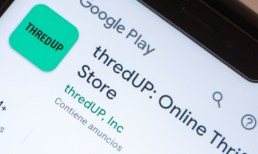Sand, Soccer and Smartphones: Why Brazil Leads the Mobile Shopping Revolution

Sandy beaches and soccer aren’t Brazil’s only calling cards. The South American nation is far ahead of some more developed countries in mobile commerce, with shoppers routinely pulling out their smartphones to buy everything from groceries and clothing to electronics and beauty products.
A forthcoming report from PYMNTS Intelligence, commissioned by Visa Acceptance Solutions, reveals that Brazilian consumers aren’t just embracing mobile shopping; They’re outpacing much of the globe, with 61% using their phones for their latest retail purchase, regardless of whether they shopped online or in a physical store.
This figure, among many highlighted in the “2025 Global Digital Shopping Index: Brazil Edition,” represents a 10% jump since 2022 and cements Brazil’s position as a leader in mobile commerce adoption among eight countries surveyed.
What makes this surge compelling is its breadth across demographics. While younger, tech-savvy generations like Gen Z (70%) and millennials (67%) lead the charge, nearly half of Brazilian baby boomers and seniors have also become mobile-first shoppers.
The digital shift highlights how a fundamental change in consumer behavior can take place due to what economists call a “leapfrog” effect, in which consumers in rapidly developing economies bypass traditional computers and fixed-line internet adoption in favor of smartphones.
Developing countries don’t have to copy the stages of economic development that leading nations slog through. Instead, they can “leapfrog” that long and messy process and go straight to cutting-edge technologies. In one respect, Brazilian consumers’ embrace of their mobile phones for retail shopping is a prime example.
Outpacing the US
Brazil boasts the highest rate of mobile phone usage for shopping in-store among all countries surveyed by PYMNTS Intelligence, including Australia, Mexico, Saudi Arabia, Singapore, the U.K., United Arab Emirates and the U.S. Brazilian shoppers have a mobile-centric mindset.
When use of phones in-store is combined with use for shopping online, Brazilians rank fourth, behind the UAE, Saudi Arabia and Singapore, in deploying their devices to make retail purchases. That still puts them ahead of consumers in the technologically advanced U.S. (42%), Australia (43%) and U.K. (49%).
The country’s digital momentum is driven by its young, tech-savvy population and near-universal smartphone access (nearly 90%). But Brazil has also gotten a big boost from financial technology firms and a government that are thinking big.
Mercado Libre, Brazil’s answer to Amazon that is the largest eCommerce and payments ecosystem in Latin America, has attracted millions of Brazilian shoppers to its online marketplace. Sao Paolo-based digital bank PicPay, through partnerships with Meta and Microsoft, began offering access to Brazil’s Pix instant payment system last fall. The country’s central bank launched Pix in 2023; it now accounts for about 40% of the total value of all digital transactions in the country, on par with credit cards.
Tale of Two Shopping Cities
But just because Brazilians like their mobile shopping doesn’t mean it’s painless. The forthcoming report, which publishes on Wednesday (April 23), reveals that nearly all (99%) Brazilian shoppers experienced at least one payment issue during their last retail transaction. The most common pain point is payment processing errors, affecting nearly 7 in 10 consumers, with declined payments the primary driver.
Some of the pain may be self-inflicted. Brazilian shoppers are more likely to manually enter their payment information for their latest online purchase, a rate 1.5 times higher than the global average of 21%. Cue the typos and fat fingers: Only 1.5% of Brazilian shoppers report a completely smooth transaction compared to the global average of 61%.
It’s no surprise then that one-third (33.8%) of Brazilian merchants express high concern that their current payment systems will not meet their — or consumers’ — future needs.
Key Takeaways:
• Brazil is a leader in mobile shopping adoption across all age groups, presenting an opportunity for businesses to engage with a mobile-first consumer base.
• Pervasive payment friction, particularly declined payments and processing errors, is a major bottleneck in the Brazilian retail market, demanding urgent attention and investment from merchants to improve customer experience and drive sales.
• Brazilian merchants need to bridge the gap between strong consumer demand for seamless online and cross-channel experiences and the current limitations in payment processing, manual checkout processes and cross-channel offerings to remain competitive and capitalize on the evolving digital landscape.
The “2025 Global Digital Shopping Index: Brazil Edition” paints a picture of a dynamic yet challenging digital marketplace. While Brazilian consumers are at the forefront of mobile shopping adoption, improvements in payment processing and the overall checkout experience are crucial to unlock the full potential of this mobile revolution.
Read more:
How Brazil Does Digital: Think Infrastructure with a Side of Instant Payments
Brazil’s Pix to Start Enabling Installment Payments in September
Brazil’s Pix Lays Foundation for ‘Perfect’ Digital Financial Ecosystem



